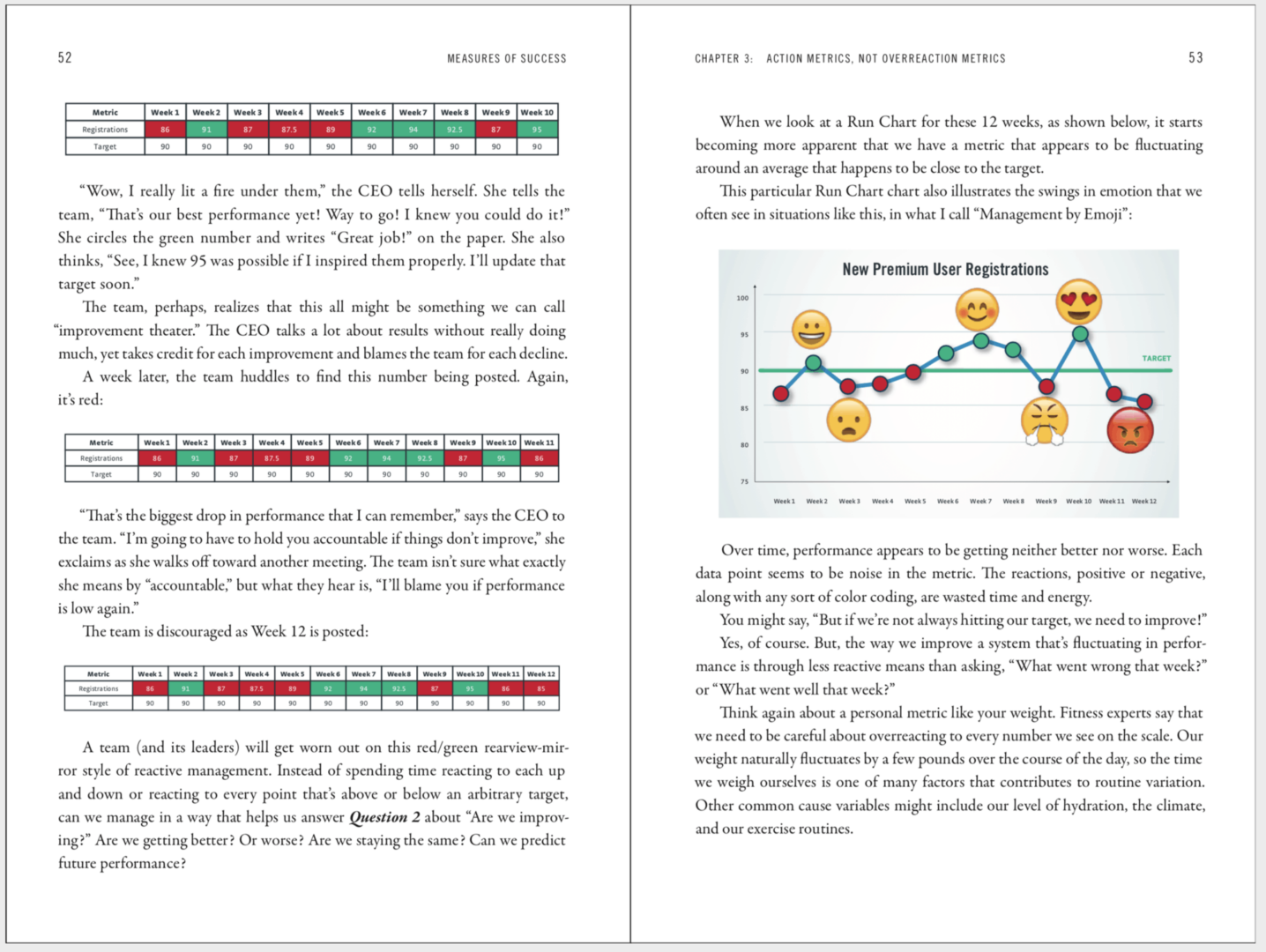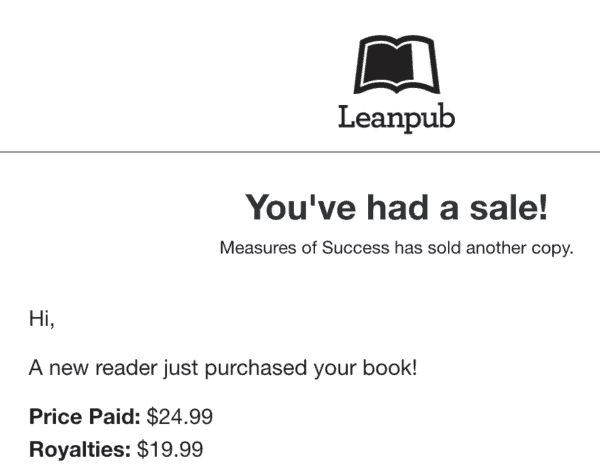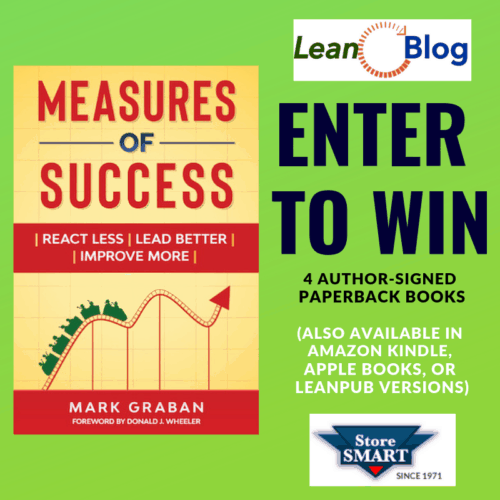I'm going to think out loud here about book pricing for the paperback version of Measures of Success: React Less, Lead Better, Improve More — in the name of transparency and getting input, I'll share some thoughts below.
As for timing, the company that's doing the interior book layout and design for me is fixing three small things and then the book is done after a few iterations with them. I am also finishing the back cover design. This could all be done as early as Monday, which means I could then submit everything for printing. If I print through Amazon, books should be available within a few days. If I print through IngramSpark, it will take a few weeks to get available.
Back to pricing… it will cost me $19 to get a 260-page color book printed by Amazon to be sold through their website around the world. This is print-on-demand technology. It would cost less than $10 to get the book printed by IngramSpark, but it seems the path of least resistance is to have Amazon print the book if they're going to sell it.
I've read that Amazon often shows books as “out of stock” if they are having to order from a distributor like IngramSpark. That might be the realities of the supply chain if Amazon is trying to gauge demand (although publishing industry norms say that books can be returned to the publisher). But, others claim Amazon intentionally treats books better if you're letting them do the printing.
Printing Through Amazon
With a printing cost of $19, t
If I charge $34.95, I make $2 a copy.
At a price of $39.95, I make $5 a copy.
At $49.95, I make $11 a copy.
These prices seem high.
Printing Through IngramSpark
It's a bit more complicated through IngramSpark. But I'll have to go through this process for retailers other than Amazon anyway.
Through this calculator, I can set the selling price and the discount that the retailer gets as the wholesale price. You're encouraged to set the wholesale discount to 55% to be most appealing to retailers, including Amazon, who would still sell and fulfill the book.
Using this method:
At a retail price of $29.95, I make $6 a copy.
At $24.95, I make about $4 a copy.
It seems like using IngramSpark is win/win for me and the readers/buyers.
Printing through Amazon means it will be available for readers more quickly. It *is* possible for me to start with Amazon printing and then convert over to IngramSpark. But, I don't like the idea of essentially charging a higher price to early adopters (although publishing does this all the time when they release a hard cover at a higher price and then release the paperback at a lower price).
Talking Through This More
My main goal is to get the book into as many readers' hands as possible. I want ideas to spread. There are opportunities for me to then earn income from speaking, training, and coaching. I'm not trying to maximize royalties on the book itself — but I'm curious what readers think a fair price would be and what the perceived value is. Prices should be based on the market and value to the reader, not the cost of production.
The Kindle version will remain under $10. I make $3.50 per copy at a $9.99 price. My book, with all of the photos, has a relatively large file size, so Amazon takes the electronic distribution cost out. I can take some steps to reduce the file size without hurting image quality, which might then boost my royalties a bit.
If I sell books directly (signed copies and/or in bulk), I can buy those from IngramSpark at the lower $10 cost, which means the margin on selling books directly is much higher — but Amazon will dominate overall sales.
This book, again, is full-color, with about 130 charts and graphics that are in color. For a book that often decries the use of “red is bad, green is good” evaluation of metrics… using color for illustrations of those “bad practices” leads to the use of color in illustrating better ways to visual metrics and better ways to evaluate those metrics. I didn't think a black and white book, while cheaper, would do the topic justice.
Below are two pages from the book. On the left-hand page, I'm making the case that a so-called “bowling chart” list of numbers with red/green color coding is not the best way to manage a system. On the right, I talk about how charting the numbers might not help if the leader still overreacts to every up and down in a metric.

Pricing History and Comparables
People have chosen to pay, through the Leanpub “choose your own price” model prices including $24.99 and $29.99, but most people choose a lower price (as low as $11.99). That tells me that at least some people see value in the book at that price.

For comparison, Don Wheeler's classic book Understanding Variation is priced at $41. It's a smaller, black-and-white book. He wrote the foreword for my book and I'm very thankful for that.
My first book Lean Hospitals is priced at $50 — that's a price that's set by the publisher. I think the price is too high, but it sells very well anyway (and my publisher claims they're pricing to the market, even though the printing cost for each copy is probably about $5). The publisher asks $70 for my other book Healthcare Kaizen, which is a 400-page full-color book. This book does not sell as well (probably due to the price point).
A few other thoughts: I can always lower the price after launch. I can hope that Amazon chooses to discount the price. I should probably test a higher price and, if needed, experiment with a lower price after that.
My book, like Don's, has a lot of useful practicality to it. I've received many emails from readers who have found almost immediate benefits to using these methods in healthcare and other service-sector businesses.
The book has been well reviewed… and, better yet, the methods are being put to use and, even better yet, people are seeing great benefits: they're wasting less time reacting to every up and down and they're better focusing their improvement efforts in ways that improve the system instead of just explaining the results.
What are your thoughts on the pricing and the value proposition? Please leave a comment.

You can also enter to win one of four FREE signed copies.
Please scroll down (or click) to post a comment. Connect with me on LinkedIn.
Let’s work together to build a culture of continuous improvement and psychological safety. If you're a leader looking to create lasting change—not just projects—I help organizations:
- Engage people at all levels in sustainable improvement
- Shift from fear of mistakes to learning from them
- Apply Lean thinking in practical, people-centered ways
Interested in coaching or a keynote talk? Let’s start a conversation.










In response to input on pricing for your new book, I see value to me as a reader/practitioner even at $39.95 via Amazon. Using Amazon makes the book easy to find l, quick to deliver especially if you have “Prime” and the option for hard copy or kindle from one web site. Even better, would be if there was the option for a bundle with both hard and soft copy. I like Kindle books when I travel but I struggle with the format in general. I Love a hard copy that I can highlight and add sticky notes of varying colour and sizes.
Keep up the good work.
Thanks Stephen. Amazon has a program called “matchbook.” If you buy the paperback you can get the Kindle version at a discounted price. I will be sure to set that up.
Also, if I have Ingram-Spark do the printing, it would still be sold and fulfilled by Amazon, which should include Prime shipping. I will edit the post to make that more clear.
Go with IngramSpark… the book is already available as hardcover and kindle, right? So making it instantly available has already been realized. No need to fill the bank vaults of Amazon through their printing process.
It’s not available in hard cover or any print form yet.
I vote IngramSpark at 29.95.
I would pay $30-40 for 3 copies. If it was more than that, I would probably encourage the people I want to buy it for to start using Kindle. I like the lean nature of on-demand printing, but I would really rather wait longer and have you receive more royalties. You provided the real value in your writing and the way it is an immediately implementable process the way you broke it down and explained it. I think the proportion of the revenue should favor you, not the printer.
One of my grumbles about my previous publisher for books like “Lean Hospitals”:
Mark, I like the IngramSpark option … the $29.95 price. Mike
I like the I.S option and $29.95 seems like a good price point. I buy my books through Amazon Prime, and temporarily out-of-stock situations do not affect my decision to buy (if its a book that I want to buy, I’ll wait a few extra days).
It’s interesting that Amazon is currently choosing to discount the book by 52%, down from $34.95 to $16.72.
This price is lower than their printing cost. That’s an interesting strategy on their part.
I”m happy that people can get the lower price. I feel bad for people who ordered on the first day before Amazon started discounting the book.
https://amzn.to/2YavW7Z
I also got this from IngramSpark today…. 2% isn’t a big deal, but they seem to feel entitled to raise prices because of higher costs: